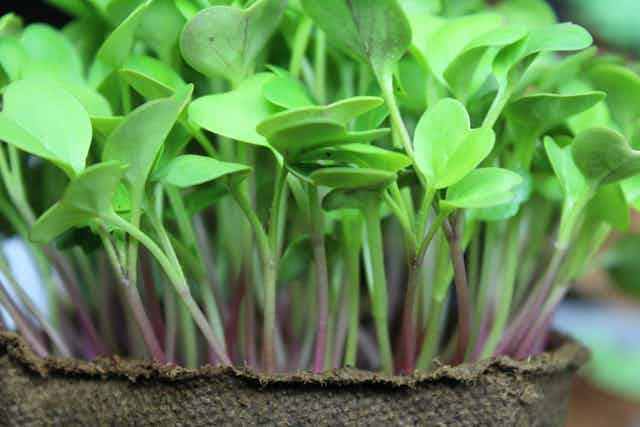Microgreens, tiny versions of leafy vegetables and herbs, have been described as healthier than full sized greens. They’re also more expensive.
So, do microgreens really contain more nutrients? Do they have other benefits? And are they worth the extra price?
Microgreens, also called “vegetable confetti”, are grown in a similar way to regular vegetables and other plants. But they are harvested when the plant is no taller than 5cm, which takes about 1-3 weeks from when the seeds are sown.
Microgreens are not to be confused with beansprouts or alfalfa, which are the young seedlings typically eaten whole within a few days, and usually grown in water.
Most microgreens were originally grown for chefs to use in restaurants. Micro versions of basil, coriander, chard, beetroot and red garnet amaranth were originally used to complement the flavour of dishes and as a garnish. Since then, their popularity has widened. You can even buy pots ready to grow your own.
More than 16,000 news items had been published about microgreens by March 2017. As well as their supposed health benefits, articles suggest they can encourage children to grow and eat more vegetables and can be grown in small spaces, so could be a useful addition to urban diets.
Is smaller better?
A US study looked at nutrient levels of 25 different microgreens and compared them to published information on full-sized leafy vegetables and herbs.
Nutrient levels in different microgreens varied. But they typically had higher levels per gram of vitamin C, vitamin E and carotenoids (plant compounds, some used to make vitamin A and others help maintain eye health) than mature crops.
So, could these nutritionally “super charged” leaves be a quick way to improve our diet?
Microgreens are clearly more nutrient dense, meaning typically they are more concentrated sources of vitamins and minerals. And like the full sized versions, microgreens are equally low in energy (about 120kJ or 29kcal per 100g based on US data). No Australian analysis of microgreens is currently available.
But can we afford to eat enough of them to make a difference? For example, micro red cabbage contains a mighty 103mg of vitamin C per 100g compared to full sized red cabbage at 69mg for the same amount. Yet the cost difference means you could buy half a regular cabbage for the price of a small pot of micro version.
The Australian Guide to Healthy Eating recommends about 75g or a cup of leafy vegetables as a serve and we should aim to eat at least five serves of vegetables a day. So, an attractive garnish of microgreens is likely to either result in a hole in your wallet or you, like so many Australians, would fall short of the recommended daily five serves of vegetables as you probably couldn’t eat enough of them.
Although rich in nutrients, perhaps the “vegetable confetti” name reveals the likely small contribution they make to total vegetable and nutrient intake.
Microgreens have a place
While the total contribution to nutrient intake from microgreens is likely to be small, they do potentially have a place in our homes. There is some evidence growing vegetables particularly in schools can help encourage children to eat more vegetables and a more varied diet. So, growing microgreens and moving beyond simple mustard and cress could help inspire the next generation to eat more healthily.
From a culinary perspective, many of the microgreens are herbs, and the leafy vegetable varieties can have different flavours when small. These may be sweeter or more peppery and can add new flavours to lift recipes not just visually but with respect to taste too. It could even potentially have a health side effect as the fascinating flavours from these small plants could reduce the desire to add additional seasoning, having an indirect health benefit.
Microgreens may be one of the latest in a long list of food trends and may have some mathematical merit in terms of the foods being a little richer in nutrients. But their true value is more than likely to relate to growing your own vegetables. In small way, this can make us feel more attached to our food supply.
Being attached to our food supply and looking beyond the “superfood” hype and nutrient levels, these little veggies take an important place in our kitchen, reminding us where our food comes from and encouraging us, especially younger ones, to try new foods and flavours. This attachment to food may even encourage us to choose to eat more healthily overall.

